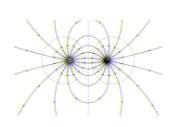Polar molecules and nonpolar molecules are the two primary types of molecules. Some molecules are obviously polar or nonpolar, whereas others fall somewhere in the between.
In polar compounds, the existence of one or more polar bonds is required due to a difference in electronegativity between the attached atoms. If the bond dipoles cancel each other out, molecules with polar bonds have no molecular polarity.
When there is a net dipole, the molecule is called a polar molecule. When the net dipole is 0 or say cancelled out, then the molecule will be called a nonpolar molecule.
Dipole:
A physical dipole is made up of two equal and opposite point charges, or two poles (as the word di-pole implies). Its large-distance field is mostly totally determined by the dipole moment.
Electronegativity of an atom:
Electronegativity is the amount of pull that an atom applies to its electrons. This force of attraction is not always the same.
Examples of atoms with higher electronegativity are oxygen, fluorine, etc. They exert greater forces on their electrons in contrast to those atoms which have lower electronegativity.
Examples of atoms with lower electronegativity are Alkali metals and alkaline earth metals.
Partial charge:
These charges are created due to a non-symmetric spread of electrons in bonds made between atoms. This asymmetric distribution can occur due to the electronegativity difference between the atoms of different kinds.
These are non-integer charge values when the charge is measured in units of the elementary charge.
They are referred to as partial charges because the amount of charge separated in such dipoles is often smaller than a fundamental charge.
Polarity of molecules:
Polarity is defined as the separation of electric charge in a molecule or its chemical groups, which results in an electric dipole moment with a negatively and positively charged end.
The polarity of molecules is often referred to as molecular polarity.
Because of the difference in electronegativity between the connected atoms, the presence of one or more polar bonds is essential in polar compounds. If the bond dipoles cancel each other out, molecules with polar bonds have no molecular polarity.
When two atoms or more atoms are bonded together to form molecules, the difference in their electronegativity causes them to attract the electrons present in the molecule by less and more force and not always with equal force.
This difference in the pull creates the difference in the sharing of electrons in the resulting molecule. Atoms with more electronegativity will attract electrons and will get a bigger share of electrons compared to those with lower electronegativity.
Because electrons have a negative charge, the uneven distribution of electrons in the molecule will result in the formation of an electric dipole. This is a disassociation of negative and positive electric charges.
Polar molecules:
A molecule having partial negative and partial positive charges because of opposing charges from asymmetrical polar bonds is called polar molecule. Due to partial charges, we say that it has a net dipole.
Example of polar molecules:
- Molecule of water H2O
The oxygen atom is more electronegative than the hydrogen atom. That causes it to attract the electrons in the water molecule more than those two hydrogen atoms.
It causes partial positive charges on the side of hydrogen atoms, and particle negative charge on the side of oxygen atom. Due to non-cancellation of the dipole, the net dipole is formed.
Since the water molecule is polar, other polar molecules are generally dissolvable in water.
- Hydrogen fluoride molecule HF
Since an atom of fluorine is more electronegative than an atom of hydrogen, therefore, a net dipole is formed in the molecule of hydrogen fluoride. There is covalent bond in between these two atoms, and the covalent bond electrons are shifted towards the fluorine atom due to it being more electronegative than that of hydrogen atom.
Non polar molecules:
A molecule is called nonpolar if the dipole cancels out and therefore, no net dipole left on the molecule. This can happen when there is equal sharing of the electrons in between the participating atoms, or due to the symmetry formed in the arrangement of the polar bonds.
Example of nonpolar molecules:
- Boron trifluoride BF3
It has a triangular arrangement of three polar bonds on a plane. Thus, having a planar arrangement. All bonds are at 120 to their adjacent bond. This makes all the bonds symmetric. In the centre there lies the atom of boron. Even when the boron atom is less electronegative than the fluorine atom, this symmetry cancels out the dipoles, and thus, not leaving any net dipole.
- Carbon Dioxide CO2
Carbon in the centre, and higher electronegative atoms of oxygen on the outer sides. Both bonds are on a line opposite to each other. The symmetry leaves no net dipole, thus, making this molecule a nonpolar molecule.
Predicting molecular polarity:
One useful way to predict the polarity of a considered molecule is to determine the point group. If the individual bond dipole moments cancel out each other, then the molecule, in general, won’t have a dipole moment. This happens because dipole moments have magnitude and direction, thus being euclidean vector quantities, and they cancel out if they are of equal magnitude with opposite charges.
Conclusion:
Because of the difference in electronegativity between the connected atoms, the presence of one or more polar bonds is essential in polar compounds. If the bond dipoles cancel each other out, molecules with polar bonds have no molecular polarity.
When a molecule has a net dipole, it is referred to as a polar molecule. When the net dipole is zero, or wiped out, the molecule is referred to as a nonpolar molecule.
Examples of polar molecules are H2O , HF etc
Examples of nonpolar molecules are CO2, BF3 etc
 Profile
Profile Settings
Settings Refer your friends
Refer your friends Sign out
Sign out







